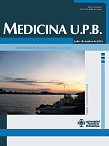4-bromo-2,5- dimetoxifeniletilamina (2CB) un riesgo en nuestro medio: serie de casos
Contenido principal del artículo
Resumen
En Medellín, la prevalencia de consumo de drogas en el último año es del 3.6% y es el grupo de edad más predominante entre los 19 y 29 años. Sin embargo, hay un subregistro relevante sobre el consumo de las nuevas drogas que son vendidas como alternativas legales a las drogas clásicas de abuso. El objetivo de este reporte es mostrar tres casos que muestran las complicaciones cardiovasculares, neurológicas y musculares asociadas con 4-bromo-2,5-dimetoxifeniletilamina (2CB), sustancia conocida en Colombia desde 2007. El consumo de 2CB está en aumento y es prioritario que los profesionales de la salud reconozcan sus riesgos.
Citas
Estudio_de_Consumo_UNODC.pdf [Internet]. [citado 21 de abril de 2016]. Recuperado a partir de: https://www.unodc.org/documents/colombia/2014/Julio/Estudio_de_Consumo_UNODC. pdf
Pérez GAC, Vallejo GAC, Fernández DYB. Consumo de drogas emergentes en Medellín, Colombia. Rev Colomb Psiquiatr 2013; 42:248–256.
Burillo-Putze G, Aldea-Perona A, Rodríguez-Jiménez C, García-Sáiz MM, Climent B, Dueñas A, et al. Drogas emergentes (I): Las “smart drugs”. An Sist Sanit Navar 2011; 34(2):263-274.
Nelson ME, Bryant S, Aks SE. Emerging drugs of abuse. Emerg Med Clin N Am 2014; 32:1–28
Alerta2CB.pdf [Internet]. [citado 21 de abril de 2016]. Recuperado a partir de: http://www.odc. gov.co/Portals/1/Docs/SAT/Alerta2CB.pdf
Burillo-Putze G, Climent B, Medina L, Toledo A. Las smart-drugs: un nuevo reto clínico en urgencias y emergencias. Emergencias 2010; 22:477-478.
Levine DA. «Pharming»: The abuse of prescription and over-the-counter drugs in teens. Curr Opin Pediatr 2007; 19:270-274.
Chary M, Genes N, McKenzie A, Manini AF. Leveraging social networks for toxicovigilance. J Med Toxicol 2013; 9:184–191.
Hill S, Thomas SHL. Clinical toxicology of newer recreational drugs. Clin Toxicol 2011; 49:705–719.
Spanagel R, Heiling M. Addiction and its brain science. Addiction 2005; 100:1813-1822.
Kalivas PW, O’Brien C. Drug addiction as a pathology of staged neuroplasticity. Neuropsychopharmacology 2008; 33:166.
Caudevilla-Galligo F. 4-Bromo-2,5-dimethoxyphenethylamine (2C-B): presence in the recreational drug market in Spain, pattern of use and subjective effects. J Psychopharmacol 2012; 26(7):1026-1035.
Dean BV, Stellpflug SL, Burnett AM, Engebretsen KM. 2C or Not 2C: phenethylamine designer drug review. J Med Toxicol 2013; 9:172–178.
Carmo H, Hengstler JG, de Boer D, Ringel M, Remiã o F, Carvalho F, et al. Metabolic pathways of 4-bromo-2,5-dimethoxyphenethylamine (2C-B): Analysis of phase I metabolism with hepatocytes of six species including human. Toxicology 2005; 206:75–89.
Shulgin AT, Shulgin A. PIKHAL—A Chemical Love Story. Berkeley, CA: Transform Press; 1991.
Lonkhuyzen JJN-V, Riel AJV, Brunt TM, Hondebrink L. Pharmacokinetics, pharmacodynamics and toxicology of new psychoactive substances (NPS): 2C-B, 4-fluoroamphetamine and benzofurans. Drug Alcohol Depend 2015; 157:18–27.
Theobald DS, Maurer HH. Identification of monoamine oxidase and cytochrome P450 isoenzymes involved in the deamination of phenethylamine-derived designer drugs (2C-series). Biochem Pharmacol 2007; 73:287–297.
Rohanova M, Pálenícek T, Balíková M. Disposition of 4-bromo-2, 5-dimethoxyphenethylamine (2C-B) and its metabolite 4-bromo-2 -hydroxy-5-methoxyphenethylamine in rats after subcutaneous administration. Toxicol Lett 2008; 178:29–36.
De Boer D, Bosman I. A new trend in drugs-of-abuse; the 2C series of phenethylamine designer drugs. Pharm World Sci 2004; 26:110–113.
Maurer HH. Chemistry, pharmacology, and metabolism of emerging drugs of abuse. Ther Drug Monit 2010; 32:544–549.
Ambrose JB, Bennett HD, Lee HS, Josephson SA. Cerebral vasculopathy after 4-bromo-2,5- dimethoxyphenethylamine ingestion. Neurologist 2010; 16:199–202.
Huang HH, Bai YM. Persistent psychosis after ingestion of a single tablet of ‘2C-B’. Prog Neuropsychopharmacol Biol Psychiatry 2011; 35:293–294.
Subbe CP, Bottle RA, Bell D. Acute Medicine: triage, timing and teaching in the context of medical emergency admissions. Eur J Intern Med 2011; 22:339–343.
Nogue S, Ramos A, Portillo M, Bohils M. Adecuación de un sistema de triage y del circuito asistencial en urgencias al paciente intoxicado. Emergencias 2010; 22:338-344.
Greene SL, Kerr F, Braitberg G. Review article: amphetamines and related drugs of abuse. Emerg Med Australas 2008; 20:391–402.
Schmidt MM, Sharma A, Schifano F, Feinmann C. Legal highs on the net-Evaluation of UK-based Websites, products and product information. Forensic Sci Int 2011; 206:92–97.
Nogue S. Toxicólogo y urgenciólogo: una nueva variante del cangrejo ermitaño. Emergencias 2009; 21:62-64.
Holstege CP, Dobmeier SG, Bechtel LK. Critical care toxicology. Emerg Med ClinNorth Am 2008; 26(3):715–739.
Rao TL, Mummaneni N, El-Etr AA: Convulsions: an unusual response to intravenous fentanyl administration. Anesth Analg 1982; 61(12):1020–1102.
Cromhout A. ED drugs. Ketamine: its use in the emergency department. Emerg Med 2003; 15:155–159.


